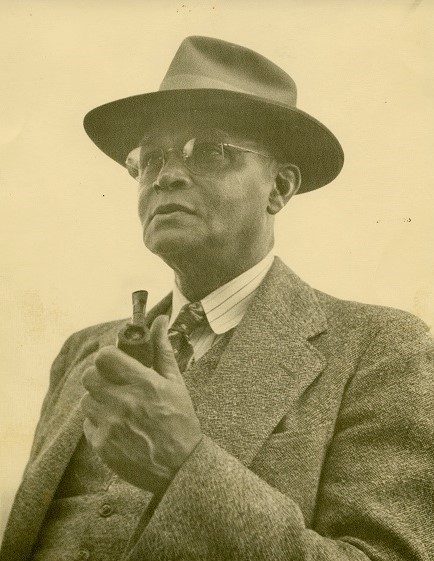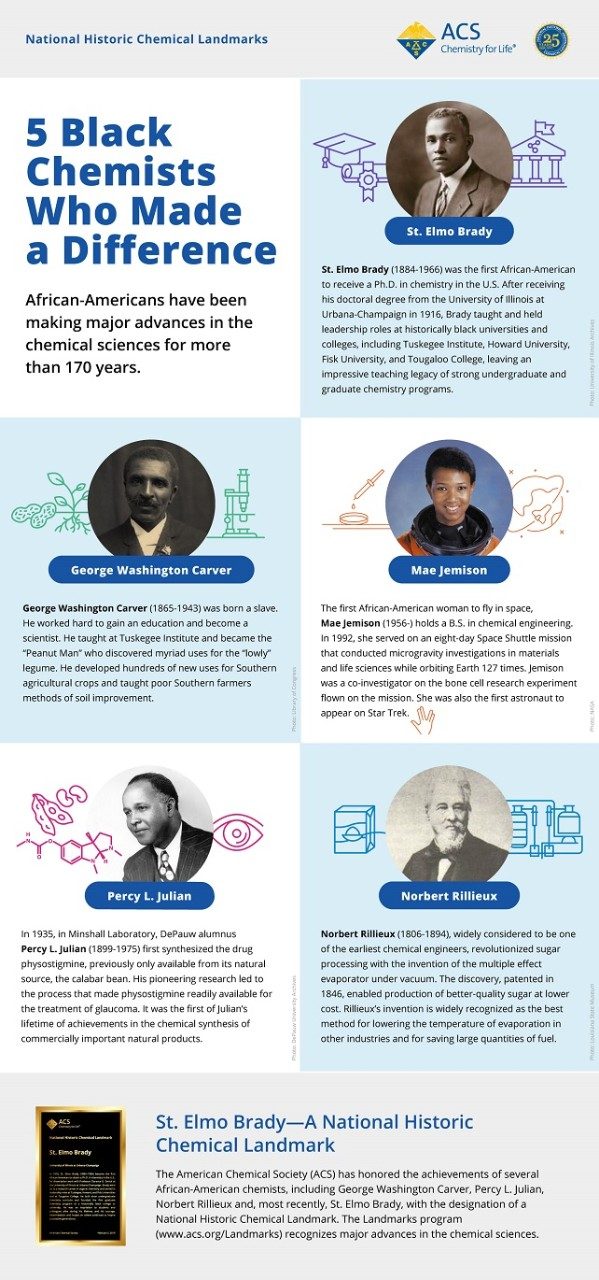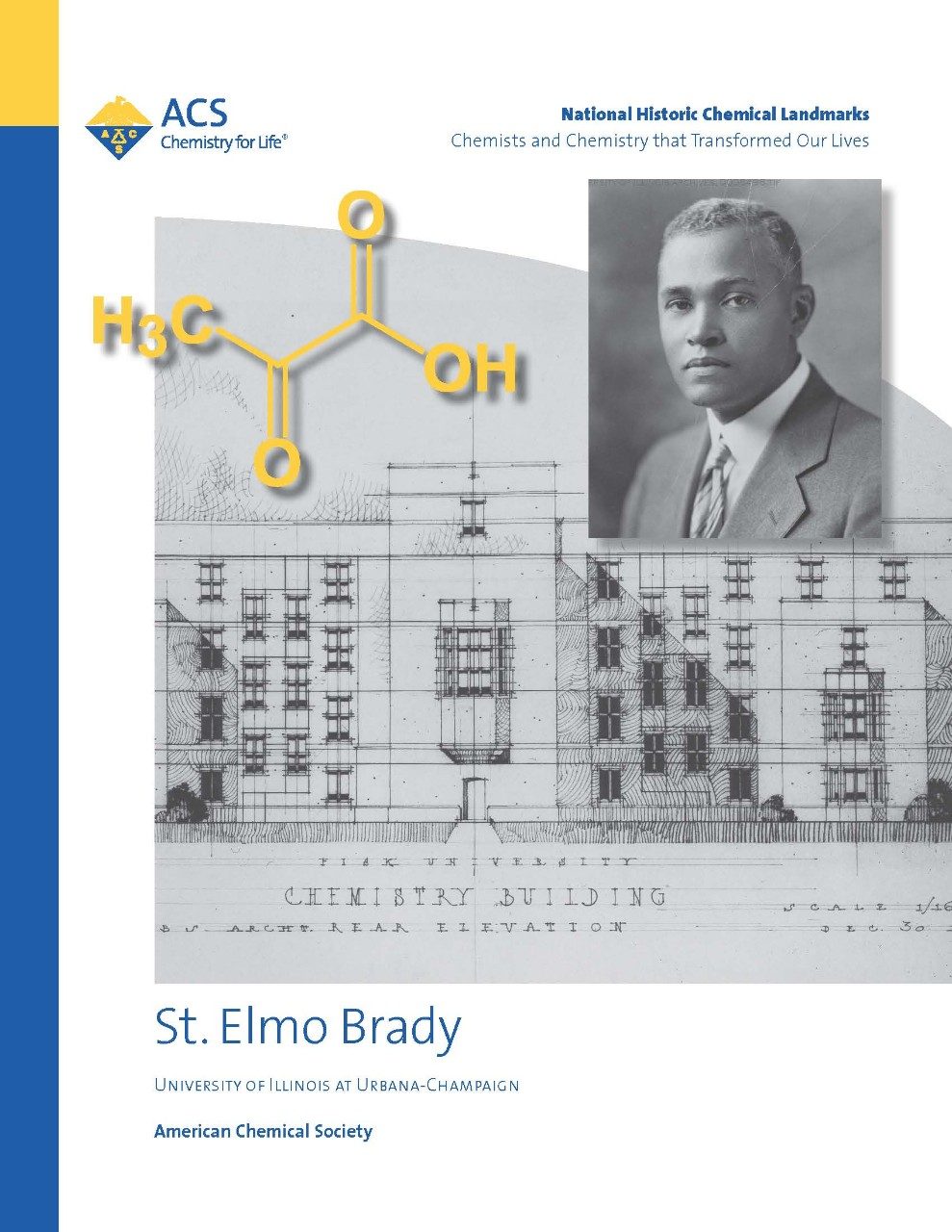St. Elmo Brady
St. Elmo Brady was the first African-American to receive a Ph.D. in chemistry. Equally as significant, Brady went on to build chemistry curricula, faculty, programs and facilities at four major historically black colleges and universities (HBCUs), where he and his colleagues mentored multiple generations of African- American chemists. His life was truly an inspiration to all who had the privilege to meet him, and his legacy lives on. For his life-long accomplishments, Brady is being honored by the American Chemical Society with a National Historic Chemical Landmark. The Landmark is being designated and celebrated at the University of Illinois, Urbana- Champaign, where he received his Ph.D. in 1916, and at the four HBCUs where he served in leadership positions: Tuskegee University, Howard University, Fisk University and Tougaloo College.
Becoming a chemist
Brady was born on Dec. 22, 1884, in Louisville, Kentucky, the eldest of three children of Thomas Alexander Brady and Celester (Parker) Brady. He graduated from Louisville Colored High School in 1903 and at the age of 20 left home to attend Fisk, an all-black college in Nashville, Tennessee, founded in 1866. There, his chemistry teacher, Thomas W. Talley, encouraged him to study chemistry.
Brady graduated with a bachelor’s degree in 1908 and took a teaching position at Tuskegee Normal and Industrial Institute (now Tuskegee University) in Alabama. After four years teaching at Tuskegee, Brady was offered a scholarship to study at the University of Illinois, Urbana- Champaign. He took a leave of absence from Tuskegee and began at Illinois in the summer session of 1913. He completed his M.S. in chemistry in 1914 and continued his graduate studies under Professor Clarence G. Derick.
Brady published three scholarly abstracts with Derick in Science between 1914 and 1915 and also collaborated with Professor George Beal on a paper titled “The Hydrochloride Method for the Determination of Alkaloids,” published in the Journal of Industrial and Engineering Chemistry.
Brady’s main focus for his Ph.D. research was settling a scientific disagreement between his advisor and the eminent Harvard chemist Arthur Michael. Derick and Michael disagreed on how the acidity of carboxylic acids was affected by replacing hydrogen atoms on the carbon chain with other chemical groups. In his Ph.D. research, Brady investigated the acidity of straight- chain carboxylic acids in which a pair of hydrogen atoms was replaced with an oxygen atom to give a keto acid.
Brady’s research resulted in a number of firsts, including new methods for preparing and purifying certain compounds and clarifying the influence of carbonyl groups on the acidity of carboxylic acids, an early contribution to the nascent field of physical organic chemistry. Brady’s studies supported Derick’s view, and he and others concluded that Michael’s view was incorrect.
Brady completed his Ph.D. after only two years, giving an oral defense of his 228-page dissertation, titled “The Scale of Influence of Substituents in Paraffine Monobasic Acids. The Divalent Oxygen Atom,” on May 22, 1916. He was the 40th person to receive a Ph.D. in chemistry from the University of Illinois, which granted its first chemistry doctorate in 1903, and the first African-American chemist to earn that distinction in the U.S.
Brady was well aware of the challenges he overcame and his role in breaking down barriers. He lived in a segregated community, where finding housing was among the many challenges he faced. Yet he didn’t talk about any of the difficulties, said his granddaughter, Carol Brady Fonvielle, in an interview. Her grandfather had a good sense of humor and cared for all people, she said. “My grandparents used to speak in terms of being good for the race.”
Notably, while at the University of Illinois, Brady became in 1914 the first African-American admitted to Phi Lambda Upsilon, the chemistry honor society, and in 1915 was one of the first African-Americans to be inducted into Sigma Xi, the science honor society. In November 1916, The Crisis, the monthly magazine of the National Association for the Advancement of Colored People, selected Brady for its biographical sketch as “Man of the Month.”
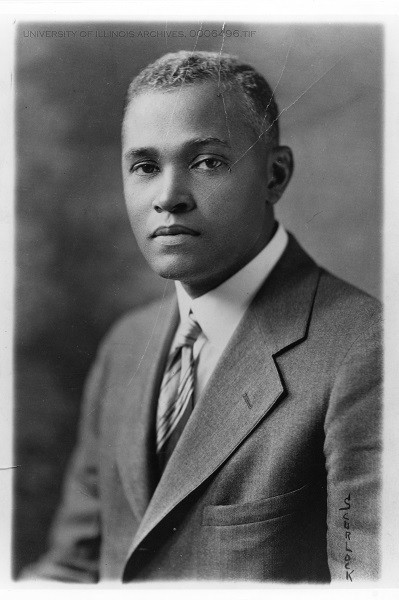
“St. Elmo Brady was a pioneer in the chemical sciences, and someone who continues today to serve as a role model for young people, particularly those with diverse backgrounds who are interested in pursuing a career in chemistry or related disciplines.”—Jonathan V. Sweedler, University of Illinois at Urbana- Champaign, 2019
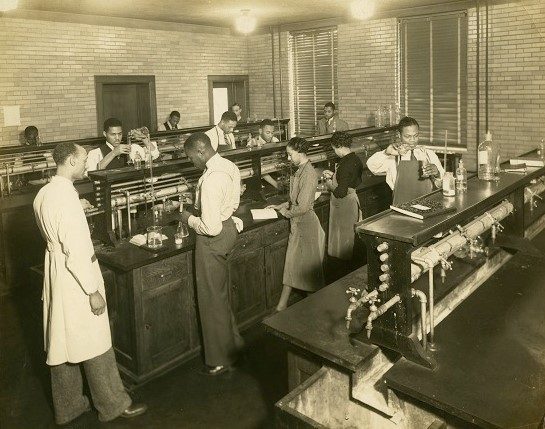
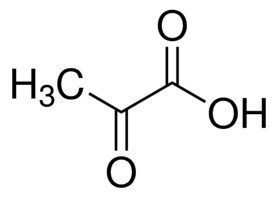
Teacher, scholar, leader
On receiving his Ph.D., Brady “had to make a big decision,” recalled Samuel Massie, a distinguished African-American chemist at the U.S. Naval Academy, in a tribute published in The Capital Chemist in 1967. “Should he go into industry, with its greater opportunities and richer financial rewards, or should he return to Tuskegee? He chose the latter and for four more years he developed his first department.” At Tuskegee, he served as head of the Division of Science and developed the undergraduate program in chemistry. In 1917, he published a 66-page monograph on Household Chemistry for Girls.
Brady was interested in research as well as teaching, and in 1920 he accepted an offer to chair the chemistry department at the better-resourced Howard University, an HBCU founded in 1867. “For seven years, he labored to establish a reputable undergraduate department [that would well prepare students] to begin graduate work, leading to a master’s degree,” Massie wrote. Also at Howard, in 1921, Brady and two colleagues initiated the first graduate program in chemistry at an HBCU. He raised funds for a new chemistry building, but in 1927, before the building was started, he received the call to return to Fisk.
Brady became chair of Fisk’s chemistry department, where he made perhaps his greatest impact as a chemist, mentor and leader. Over the next 25 years, he transformed the department at this leading HBCU. He taught general and organic chemistry to hundreds of students. He assembled an outstanding chemistry faculty and developed an undergraduate curriculum. In honor of his mentor, he began the Talley Lectures, which drew many famous chemists to Fisk. He obtained funds for one of the first infrared spectrophotometers and in collaboration with the University of Illinois established a summer program in infrared spectroscopy that was open to faculty from all colleges and universities. In conjunction with the physics department at Fisk, the famed Infrared Spectroscopy Institute was founded.
Brady also continued his own research at Fisk. His investigations resulted in a number of publications, including a 1938 paper on phytochemicals in magnolia seeds in The Journal of the American Pharmaceutical Association, a 1939 paper on the reactions of ricinoleic acid in the Journal of the American Chemical Society, and a 1951 paper on the preparation of 1,1-dichloroheptane in Proceedings of the Oklahoma Academy of Science.
Groundbreaking building
In one of his most lasting contributions to Fisk, he coordinated construction of the first modern chemistry building at an HBCU. The building opened in 1931, only four years after his return and five years before the new facility at Howard, which he helped raise funds for, was complete.
The Fisk facility now bears the name Talley-Brady Hall and is on the U.S. National Park Service’s National Register of Historic Places. The 36,500-square foot building contains teaching and research laboratories, classrooms and faculty offices. Today, hundreds of science, technology, engineering and mathematics (STEM) students pass through Talley-Brady Hall’s doors each day to take general chemistry or organic chemistry, or to work in one of the research labs.
Brady’s quarter-century of dedication in building an outstanding chemistry department helped lay the groundwork for Fisk’s reputation today as one of the leading producers of African- Americans in STEM.
After retiring from Fisk, Brady spent 14 years collaborating with educators at Tougaloo College in Jackson, Mississippi, to help build their chemistry department. “With a puff of his pipe and a twinkle in his eye, he rolled up his sleeves and began to build again,” Massie recalled. “And as at Tuskegee, Howard and Fisk, soon there arose another building, another good undergraduate program, another good chemistry faculty.” While at Tougaloo, he continued his laboratory studies of substances from privet plants. He was the first American to engage in such a study, which was aimed at developing a cancer and malaria treatment from privet berries.
Brady was married to Myrtle Marie Travers, whom he met at Tuskegee, where she taught English. They were married on Aug. 28, 1917, and had two sons, St. Elmo Brady Jr. and Robert Brady. Brady Sr. died on a bright, beautiful Christmas day in snowy Washington, D.C., in 1966 at the age of 82.
“Brady not only built buildings and departments, he built men and women,” Massie wrote. “He was never too busy to listen to the problems of a student or fellow faculty member... Although he is gone as a person, his shadow remains. It will always remain when men turn down offers for personal gain to serve others. It will always be there as a friendly teacher helps a student or a young colleague. It will show wherever better facilities in chemistry are erected... Truly the story of chemistry at four institutions is the lengthened shadow of a great teacher, friend and scholar—St. Elmo Brady.”
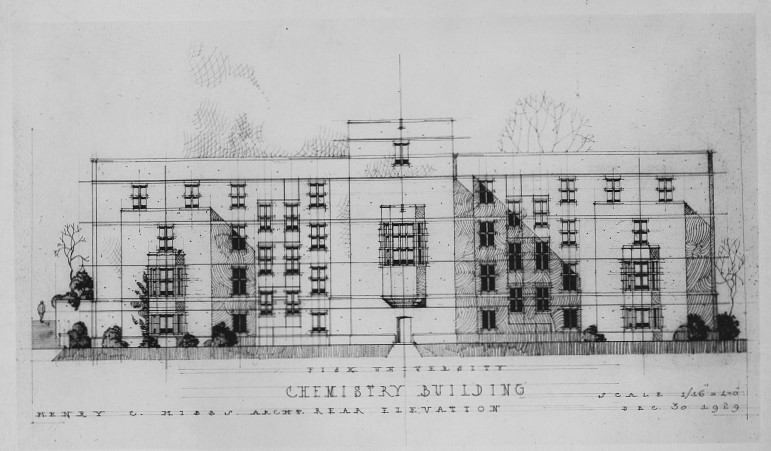
“It has been said that ‘great institutions are but lengthened shadows of the men who lead them.’ If this be so, then the work in chemistry being carried on in four institutions [today is] but lengthened shadows of the teacher, scholar and friend St. Elmo Brady.”—Samuel P. Massie, The Capital Chemist, September 1967
Landmark dedication and acknowledgements
Landmark dedication
ACS honored St. Elmo Brady with a National Historic Chemical Landmark (NHCL) in a ceremony at the University of Illinois at Urbana-Champaign, on February 5, 2019. Plaques were also prepared for installation at the HBCUs where Brady worked. The commemorative plaques reads:
In 1916, St. Elmo Brady (1884-1966) became the first African-American to obtain a Ph.D. in chemistry in the U.S., for dissertation work with Professor Clarence G. Derick at the University of Illinois at Urbana-Champaign. Brady went on to a research career in organic chemistry and served in leadership roles at Tuskegee, Howard and Fisk Universities and at Tougaloo College. He built strong undergraduate chemistry curricula and founded the first graduate chemistry program at a historically black college or university. He was an inspiration to students and colleagues alike during his lifetime, and his courage, determination and impact on others continue to inspire successive generations.
Acknowledgements
Adapted for the internet from "St. Elmo Brady," produced by the American Chemical Society's National Historic Chemical Landmarks program in 2019.
Research resources
Further reading
- Science History Institute: St. Elmo Brady
- Wikipedia: St. Elmo Brady
- University of Illinois at Urbana-Champaign: St. Elmo Brady
- University of Illinois at Urbana-Champaign: Celebrating the legacy of St. Elmo Brady
- University of Illinois at Urbana-Champaing: St. Elmo Brady documentary
- ACS Honors African Americans in the Chemical Sciences: St. Elmo Brady
- ACS news release: First African-American chemistry Ph.D. honored with landmark during Black History Month
- C&EN: St. Elmo Brady gains chemical landmark status
- The Journal of Blacks in Higher Education: Saint Elmo Brady Honored With a National Historical Chemical Landmark
- The Daily Illini: UI dedicates plaque to chemistry student
- The News-Gazette: UI's newest landmark designation honors first black American to earn chemistry Ph.D.
